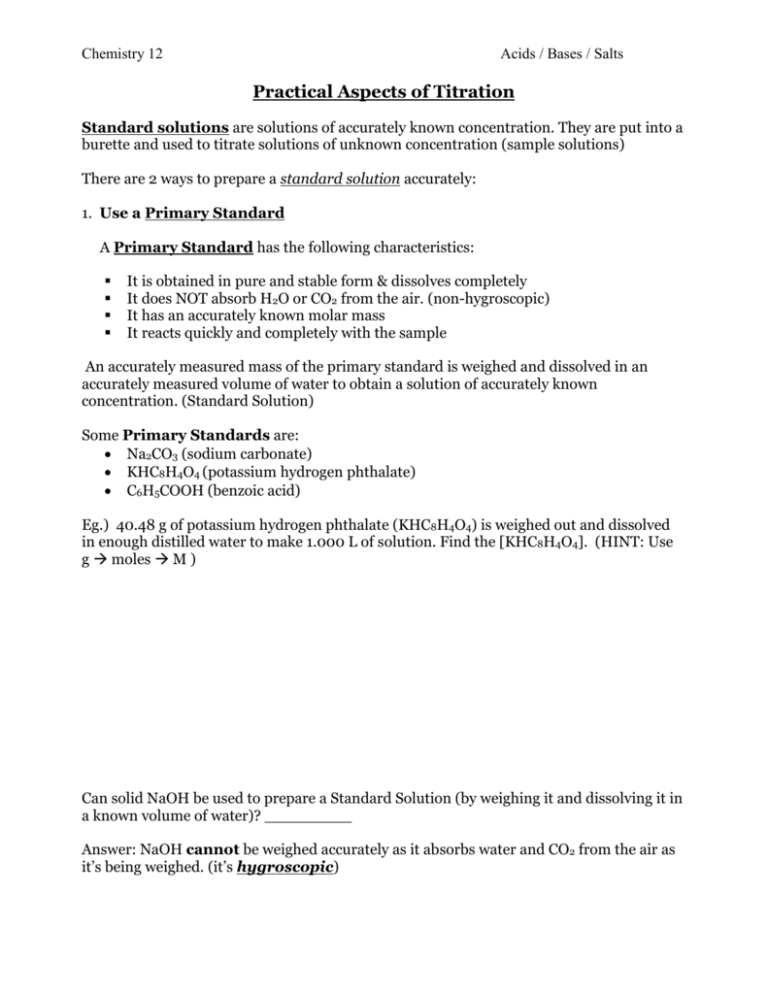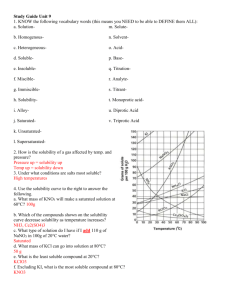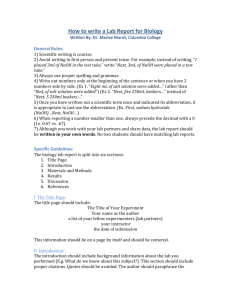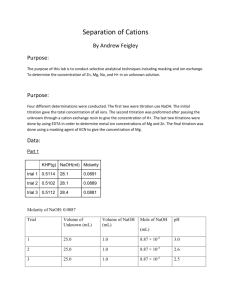Practical Aspects of Titration
advertisement

Chemistry 12 Acids / Bases / Salts Practical Aspects of Titration Standard solutions are solutions of accurately known concentration. They are put into a burette and used to titrate solutions of unknown concentration (sample solutions) There are 2 ways to prepare a standard solution accurately: 1. Use a Primary Standard A Primary Standard has the following characteristics: It is obtained in pure and stable form & dissolves completely It does NOT absorb H2O or CO2 from the air. (non-hygroscopic) It has an accurately known molar mass It reacts quickly and completely with the sample An accurately measured mass of the primary standard is weighed and dissolved in an accurately measured volume of water to obtain a solution of accurately known concentration. (Standard Solution) Some Primary Standards are: Na2CO3 (sodium carbonate) KHC8H4O4 (potassium hydrogen phthalate) C6H5COOH (benzoic acid) Eg.) 40.48 g of potassium hydrogen phthalate (KHC8H4O4) is weighed out and dissolved in enough distilled water to make 1.000 L of solution. Find the [KHC8H4O4]. (HINT: Use g moles M ) Can solid NaOH be used to prepare a Standard Solution (by weighing it and dissolving it in a known volume of water)? _________ Answer: NaOH cannot be weighed accurately as it absorbs water and CO2 from the air as it’s being weighed. (it’s hygroscopic) Chemistry 12 Acids / Bases / Salts 2. Standardizing a Solution This is done by titrating a solution with a primary standard in order to find it’s accurate concentration. The standardized solution can then be used to titrate other solutions. A Primary Standard Acid → A base solution (eg. NaOH) → Other acids of unknown conc. Example: It takes 4.02 mL of 0.1983 M KHC8H4O4 to titrate 10.00 mL of a solution of NaOH. Find the [NaOH] The balanced equation for the reaction is : KHC8H4O4 + NaOH H2O + KNaC8H4O4 So the [NaOH] = _____________ M This standardized NaOH solution can now be used to titrate other acids of unknown concentration: Eg.) It takes 28.54 mL of standardized 0.0804 M NaOH to titrate a 25.00 mL sample of an H2SO4 solution. The balanced equation for this neutralization reaction is: 2NaOH + H2SO4 2H2O + Na2SO4 Calculate the [H2SO4]. Answer [H2SO4] = ___________ M Do Ex. 121 & 122 on p. 165 Chemistry 12 Acids / Bases / Salts Practical Aspects of Titration Standard solutions are solutions of accurately known concentration. They are put into a burette and used to titrate solutions of unknown concentration (sample solutions) There are 2 ways to prepare a standard solution accurately: 1. Use a Primary Standard A Primary Standard has the following characteristics: It is obtained in pure and stable form & dissolves completely It does NOT absorb H2O or CO2 from the air. (non-hygroscopic) It has an accurately known molar mass It reacts quickly and completely with the sample An accurately measured mass of the primary standard is weighed and dissolved in an accurately measured volume of water to obtain a solution of accurately known concentration. (Standard Solution) Some Primary Standards are: Na2CO3 (sodium carbonate) KHC8H4O4 (potassium hydrogen phthalate) C6H5COOH (benzoic acid) Eg.) 40.48 g of potassium hydrogen phthalate (KHC8H4O4) is weighed out and dissolved in enough distilled water to make 1.000 L of solution. Find the [KHC8H4O4]. (HINT: Use g moles M ) 40.48 g x [KHC8H4O4] = 1mol 0.1983 mol 204.1g 0.1983mol 0.1983 M 1.000 L Can solid NaOH be used to prepare a Standard Solution (by weighing it and dissolving it in a known volume of water)? _________ Answer: NaOH cannot be weighed accurately as it absorbs water and CO2 from the air as it’s being weighed. (it’s hygroscopic) Chemistry 12 Acids / Bases / Salts 2. Standardizing a Solution This is done by titrating a solution with a primary standard in order to find it’s accurate concentration. The standardized solution can then be used to titrate other solutions. A Primary Standard Acid → A base solution (eg. NaOH) →Other acids of unknown conc. Example: It takes 4.02 mL of 0.200 M KHC8H4O4 to titrate 10.00 mL of a solution of NaOH. Find the [NaOH] The balanced equation for the reaction is : KHC8H4O4 + NaOH H2O + KNaC8H4O4 moles of KHC8H4O4 = 0.200 M x 0.00402 L = 0.000804 mol KHC8H4O4 1molKHC8 H 4 O 4 moles of NaOH = 0.000804 mol KHC8H4O4 x 0.000804 mol NaOH 1mol NaOH [NaOH] = 0.000804 mol NaOH 0.0804 M 0.01000 L NaOH So the [NaOH] = 0.0804 M This standardized NaOH solution can now be used to titrate other acids of unknown concentration: Eg.) It takes 28.54 mL of standardized 0.0804 M NaOH to titrate a 25.00 mL sample of an H2SO4 solution. The balanced equation for this neutralization reaction is: 2NaOH + H2SO4 2H2O + Na2SO4 Calculate the [H2SO4]. moles of NaOH = 0.0804M x 0.02854 L = 0.0022946 mol NaOH moles of H2SO4 = 0.0022946 mol NaOH x [H2SO4] = 1molH 2 SO4 0.0011473 mol H2SO4 2molNaOH 0.0011473 mol H 2SO 4 0.0459 M 0.02500 L H 2SO 4 Do Ex. 121 & 122 on p. 165








